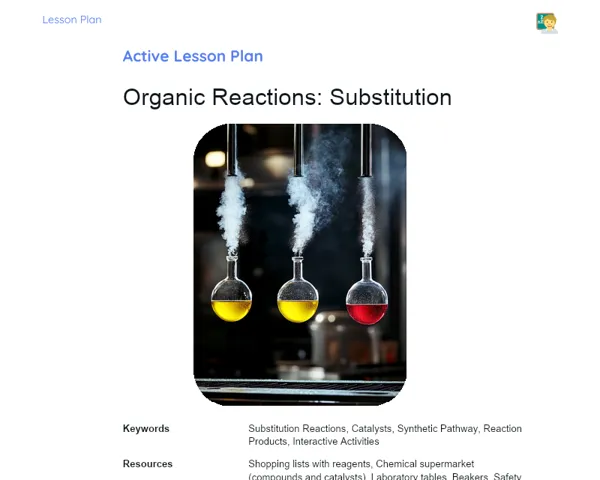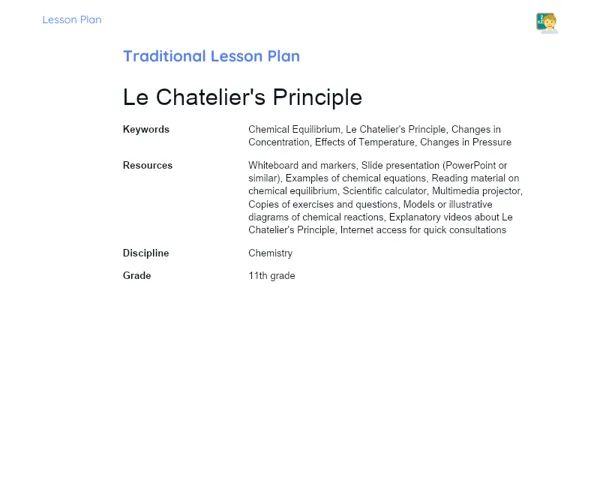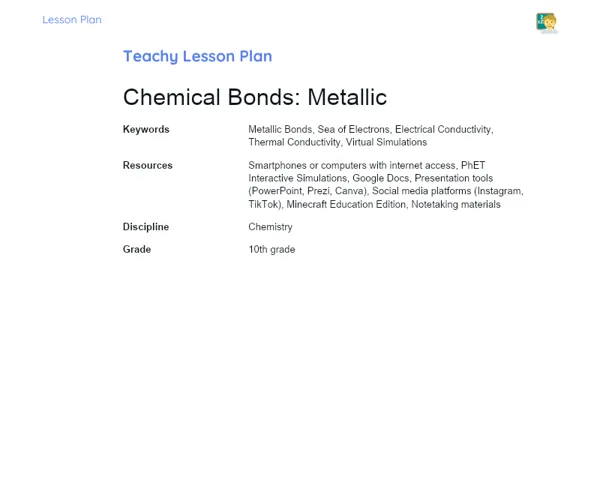Lesson Plan | Lesson Plan Tradisional | Chemical Kinetics: Activation Energy
| Keywords | Chemical Kinetics, Activation Energy, Arrhenius Equation, Temperature, Rate Constant, Catalysts, Arrhenius Graph |
| Resources | Whiteboard and markers, Multimedia projector, Presentation slides, Scientific calculators, Copies of potential energy graphs, Copies of practical exercises |
Objectives
Duration: (10 - 15 minutes)
The purpose of this step is to give students a clear overview of the lesson's main objectives, setting the stage for what will be covered and ensuring they know the skills they should develop. This step also aligns students' expectations with the content, making it easier for them to grasp and retain the information shared throughout the lesson.
Objectives Utama:
1. Use the Arrhenius equation to calculate activation energy.
2. Understand the concept of activation energy and how it relates to temperature.
Introduction
Duration: (10 - 15 minutes)
🎯 Purpose: This step aims to contextualize and introduce students to the topic of activation energy, sparking their interest and curiosity. It lays the groundwork for a deeper understanding of the concepts to be tackled in the lesson, promoting better assimilation of information and engagement with the subject matter.
Did you know?
🧪 Curiosity: Did you know that activation energy is why most foods don't spoil immediately at room temperature? It's also the reason why catalysts are highly valued in many industries, as they reduce the required activation energy, thus speeding up reactions.
Contextualization
🔬 Context: Chemical kinetics is a branch of chemistry that focuses on how quickly chemical reactions occur and the factors that affect these rates. A key concept in this area is activation energy, which is the minimum energy that must be provided for a reaction to take place. Without this energy, the reacting molecules lack enough energy to break existing bonds and form new ones. Understanding activation energy is crucial across different fields, from chemical engineering to molecular biology, as it explains why reactions happen at varying speeds.
Concepts
Duration: (50 - 60 minutes)
📚 Purpose: This part of the lesson aims to deepen students' comprehension of activation energy by laying a strong theoretical groundwork alongside practical examples. This enables them to apply the Arrhenius equation for calculating activation energy and comprehending how temperature affects the rate of chemical reactions. Class problem-solving activities will help reinforce their understanding and foster essential practical skills in chemistry.
Relevant Topics
1. Definition of Activation Energy: Discuss that activation energy is the minimum energy necessary for a chemical reaction to occur. Utilize potential energy graphs to illustrate the energy difference between reactants and products and the energy barrier that must be surpassed.
2. Arrhenius Equation: Present the Arrhenius equation: k = A * e^(-Ea/RT). Explain each term: k is the rate constant, A is the pre-exponential factor, Ea represents activation energy, R is the gas constant, and T is temperature in Kelvin. Highlight the connection between activation energy and reaction rate.
3. Influence of Temperature on Activation Energy: Examine how temperature impacts activation energy. Explain that as temperature increases, the kinetic energy of molecules also rises, allowing more molecules to achieve enough energy to overcome the activation barrier, which in turn increases the reaction rate.
4. Arrhenius Plot: Teach how to create and interpret an Arrhenius plot, where ln(k) is plotted against 1/T. Demonstrate that the slope of the graph equals -Ea/R, leading to the calculation of activation energy from experimental results.
5. Practical Examples: Share real-life examples of how to calculate activation energy using the Arrhenius equation. Work through problems step-by-step, showing how to derive activation energy from experimental data and predict the rate constant at various temperatures.
To Reinforce Learning
1. What is the activation energy of a reaction whose rate constant doubles when the temperature increases from 300 K to 310 K? (Tip: Utilize the Arrhenius equation and consider logarithmic approximations.)
2. A reaction shows a rate constant of 1.5 x 10^3 s^-1 at 298 K and 3.0 x 10^4 s^-1 at 308 K. Calculate the activation energy for this reaction.
3. Describe how the introduction of a catalyst modifies the activation energy of a chemical reaction and how this change is expressed in the Arrhenius equation.
Feedback
Duration: (20 - 25 minutes)
🔄 Purpose: This phase aims to consolidate the knowledge gained by students during the lesson. It allows them to discuss and reflect on the solutions to the posed questions. This feedback moment is essential for clearing up any confusion, reinforcing concepts, and ensuring that students thoroughly understand the material covered. Encouraging active discussion and student participation nurtures a more significant and enduring learning experience.
Diskusi Concepts
1. Question 1: Determine the activation energy for a reaction with a rate constant that doubles when the temperature goes from 300 K to 310 K. (Tip: Employ the Arrhenius equation and consider logarithmic approximations.)
Discussion: Use the Arrhenius equation in its logarithmic form: ln(k2/k1) = -Ea/R * (1/T2 - 1/T1). Given that k2 = 2k1, we have ln(2) = -Ea/R * (1/310 - 1/300). Solve for Ea using R = 8.314 J/mol*K. The activation energy should come out to approximately 52.9 kJ/mol. 2. Question 2: For a reaction with a rate constant of 1.5 x 10^3 s^-1 at 298 K and 3.0 x 10^4 s^-1 at 308 K, find the activation energy.
Discussion: Apply the same method as in the prior question. ln(3.0 x 10^4 / 1.5 x 10^3) = -Ea/R * (1/308 - 1/298). Solve for Ea. The activation energy should be roughly 88.3 kJ/mol. 3. Question 3: How does the presence of a catalyst affect the activation energy of a chemical reaction, and how is this represented in the Arrhenius equation?
Discussion: A catalyst provides an alternative reaction pathway with lower activation energy. In the Arrhenius equation, this results in a reduction in Ea, which increases the rate constant k for any given temperature, thus accelerating the reaction.
Engaging Students
1. How does activation energy affect the rate of a chemical reaction? 2. Can we conclude that every chemical reaction has an activation energy? Explain your reasoning. 3. How does a change in temperature influence the kinetic energy of the reacting molecules? 4. In what real-world scenarios is the role of a catalyst pivotal? 5. What would be the outcome of a chemical reaction if the activation energy were zero? Is this a feasible scenario?
Conclusion
Duration: (10 - 15 minutes)
The goal of this step is to summarize the main points discussed in the lesson and ensure students solidify their acquired knowledge. It also seeks to reinforce the link between theory and practice, emphasizing the content's relevance to real-life scenarios and daily applications, thereby encouraging a broader and more practical understanding of the topic.
Summary
['Definition of activation energy as the least energy required for a chemical reaction to happen.', 'Introduction and detailed explanation of the Arrhenius equation: k = A * e^(-Ea/RT).', 'Impact of temperature on activation energy and the rates of chemical reactions.', 'Construction and interpretation of the Arrhenius plot.', 'Practical examples demonstrating calculations with the Arrhenius equation.']
Connection
The lesson bridged theory and practice by utilizing practical examples and problem-solving to show how the Arrhenius equation can be used to calculate activation energy and forecast the rate constant at different temperatures. The graphs and practical exercises helped convey the theory in a clear and applicable manner.
Theme Relevance
Grasping activation energy is crucial across various sectors including the chemical and biological industries, where adjusting reaction rates is vital. For instance, catalysts are extensively employed to lower activation energy and hasten reactions, leading to more efficient industrial processes and the creation of essential substances. Moreover, activation energy sheds light on everyday occurrences like food preservation.



